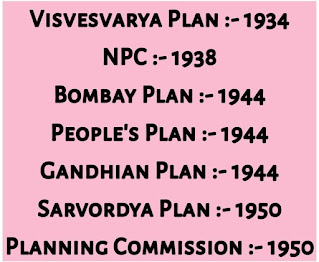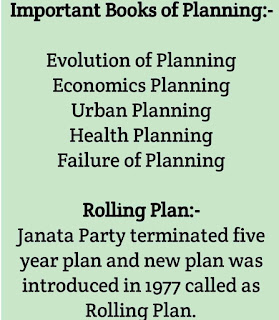Table of Contents
History of Planning in India
Who was the first to bring the concept of Planning In India?
The following are plans & committees made for building the Planning Commission in India.
Planning history of India period from 1857 to 1947 national movement
1)Visvesvarya Plan:-(1934)
Formed in 1934 under leader Visvesvarya. It gave a suggestion for a 10-year Plan. The book ‘Planned Economy in India‘ was written for Planning.
They gave a recommendation for the USA(decentralized) and focus on Industrial and increasing 6 times production of Industries and Secondary sectors.
They also Focused on Doubling the Income of the Country. He proposed a Capital of 1000 crore.
- Did you know that Visvesvarya Sir is known as the Father of Planning in India
2)National Planning Committee :-(1938)
When Subhash Chandra Bose was president in 1938 he made National Planning Committee under the leadership of Jawaharlal Nehru with 15 members in it but that didn’t continue long and got vained due to World war 2 but some of its recommendations were used in 1948.
3)Bombay Plan :-(1944)
In early 1944, several eminent industrialists and economists of Bombay, Sir Purshottamdas Thakurdas, Mr. J.R.D. Tata and six others made another attempt and published a development plan, which was called the Bombay plan.
Its main purpose was to stimulate the thinking of the people and to lay down the principles on the basis of which a national plan could be formulated and executed.
Its plan was tripling National income and double the per capita within a span of 15 years.
 |
| History-of-Planning-India |
4)People’s Plan :-(1944)
Formed under communist leader M.N.Roy in 1944. He had Marxist Socialism ideology and gave total supremacy to Agriculture.
Members included were G.D.Parakh, V.M.Tarkunde & B.N.Banerjee and the total budget was 15000 crore.
It was a 10-year plan. The basic feature of the People’s Plan was an emphasis on agriculture and social services; and, its self-financing character.
5)Gandhian Plan :-(1944)
Constituted by the principle of Wardha in 1944 by Shriram Narayan Agarwal.
The outlay for the plan was 3500 crore and it laid emphasis on small-scale industries and agriculture but was later criticized for being insufficient and inconsistent.
6)Sarvordya Plan :-(1950)
In 1950 Jai Prakash Narayan published a plan document called ‘Sarvodya Plan’.
This plan itself was inspired by the Gandhian Plan and the Sarvodaya Idea of Vinoba Bhave.
The plan emphasized agriculture and small & cottage industries.
It also suggested freedom from foreign technology and stressed land reforms and decentralized participatory planning.
7)Planning advisory board:- (1946 Interim Govt)
The interim Government was installed on 24th August 1946 and the Advisory Planning Board. The Board submitted its report in January 1947.
Its major recommendations were:-
a) The increase in production that is essential could be secured only through a well-considered plan.
b) There must be control over the use of energy sources, control over distribution and price, and as well leases and subleases.
c)It was the body of about 25-30 Members.
8)Planning Commission:- (1950)
It was an Extra Constitutional body made for 5 years in 1950. Immediately after independence in 1947, the Economic Programme Committee (EPC) was formed by the All India Congress Committee with Nehru as its chairman it recommended the Planning Commission.
1st Chairman was India’s 1st PM, Jawaharlal Nehru. It was brought in March 1950.
It balanced the public & private sectors. It was charged with the responsibility of making an assessment of all resources of the country, augmenting deficient resources, formulating plans for the most effective and balanced utilization of resources, and determining priorities. It was abolished in 2014 by Modi Govt.
Functions:-1) Make an assessment of Material Capital, allocating Funds, and distributing Funds to primary, secondary, and tertiary sectors.
When did the real planning process begin in India?
9)National Development Council :-(1952)
It is the apex body for decision-making and deliberations on development matters in India, presided over by the Prime Minister.
It was set up on 6 August 1952 to strengthen and mobilize the effort and resources of the nation in support of the Plan, to promote common economic policies in all vital spheres, and to ensure the balanced and rapid development of all parts of the country.
It helps the Planning Commission to create a decision and gives final approval to PC.
The Council comprises the Prime Minister, the Union Cabinet Ministers, Chief Ministers of all States or their substitutes, representatives of the Union Territories, and the members of the Planning Commission. It
is an extra-constitutional and non-statutory body. It helps to keep a strong bond between center and state. It was abolished in 2016.
10)NITI Aayog:- (2014)
Planning in India was carried by the Planning Commission (1950 – 2014) and the NITI (
National Institution for Transforming India) Aayog (2014 – Till Today) With the Prime
Minister as the ex-officio Chairman, the commission has a nominated Deputy Chairman,
who holds the rank of a Cabinet Minister.
It came on 1 Jan 2015. It also has a Subtitutory office with the Applied Manpower Research office.
What is the rolling plan?
Some important books related to Planning in India:-
5. Failure of Planning in India.
 |
| Important-books-planning |
Conclusion:-
The five-year plans started in 1951 helped India a lot in the development where India boosted in all 4 sectors.
India had about a 12 % GDP growth rate in the late 2000s. So this was all about the History of Planning in India.
JAY HIND….!!!!!
